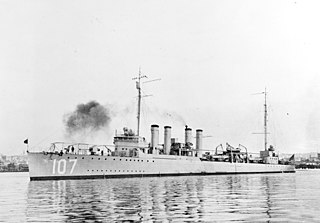
USS Murray (DD-97) was a Wickes-class destroyer built for the United States Navy during World War I.

USS Kimberly (DD-80) was a Wickes-class destroyer built for the United States Navy during World War I.

USS Dyer (DD-84) was a Wickes-class destroyer built for the United States Navy during World War I.

USS McKee (DD-87) was a Wickes-class destroyer built for the United States Navy during World War I.

USS Bell (DD-95) was a Wickes-class destroyer built for the United States Navy during World War I.

USS Mugford (DD-105) was a Wickes-class destroyer built for the United States Navy during World War I.

USS Hazelwood (DD-107) was a Wickes-class destroyer built for the United States Navy during World War I.

USS Champlin (DD-104) was a Wickes-class destroyer built for the United States Navy during World War I.

USS Hart (DD-110) was a Wickes-class destroyer built for the United States Navy during World War I.

USS Ingraham (DD-111) was a Wickes-class destroyer built for the United States Navy during World War I.

USS DeLong (DD-129) was a Wickes-class destroyer built for the United States Navy during World War I.

USS Meredith (DD-165) was a Wickes-class destroyer built for the United States Navy during World War I. She was the first destroyer in the United States Navy that named for a marine.

USS Bush (DD-166) was a Wickes-class destroyer built for the United States Navy during World War I.

USS Burns (DD-171) was a Wickes-class destroyer built for the United States Navy during World War I.

USS Anthony (DD-172) was a Wickes-class destroyer built for the United States Navy during World War I.

USS Sproston (DD-173) was a Wickes-class destroyer built for the United States Navy during World War I.

USS O'Bannon (DD-177) was a Wickes-class destroyer built for the United States Navy during World War I.

USS McDermut (DD-262) was a Clemson-class destroyer in service with the United States Navy from 1919 to 1929. She was scrapped in 1932.

USS John Francis Burns (DD-299) was a Clemson-class destroyer built for the United States Navy during World War I.

USS Zeilin (DD-313) was a Clemson-class destroyer in service with the United States Navy from 1920 to 1930. She was scrapped in 1930.





















